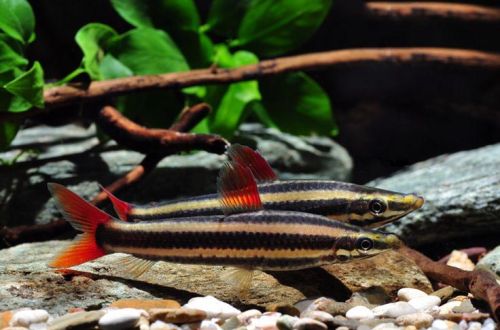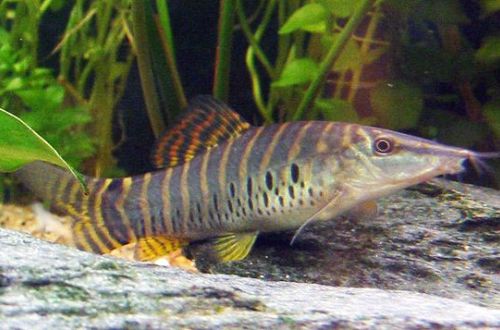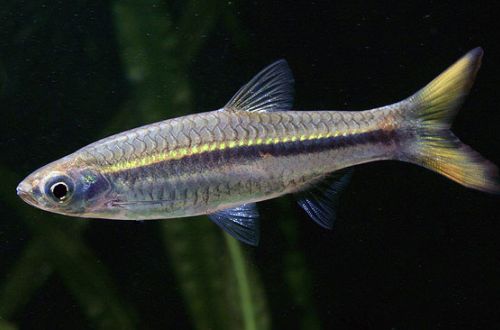
Anostomus vulgaris
The common anostomus, scientific name Anostomus anostomus, belongs to the Anostomidae family. One of the two most famous fish of this family, along with Anostomus Ternetsa. Relatively easy to maintain, although it requires several specific conditions.

Contents
Habitat
It originates from South Amkrika, where it is widely distributed in the upper reaches of the Amazonian river systems, as well as in the Orinoco River basin. The natural habitat covers vast expanses of Peru, Brazil, Venezuela and Guyana. Inhabits fast-flowing rivers with rocky shores, almost never occurs in flat areas.
Brief information:
- The volume of the aquarium – from 100 liters.
- Temperature – 20-28°C
- Value pH — 5.5–7.5
- Water hardness – 1–18 dGH
- Substrate type — stony
- Lighting – bright
- Brackish water – no
- Water movement – strong or moderate
- The size of the fish is 15–20 cm.
- Nutrition – any feed with plant components
- Temperament – conditionally peaceful
- Keeping alone or in a group of 6 individuals
Description
Adult individuals reach a length of 15–20 cm. Sexual dimorphism is weakly expressed, sexually mature males are only slightly larger than females. The fish has an elongated body and a pointed head. Coloration consists of alternating horizontal dark and light stripes. The fins and tail are red.
Food
Omnivorous species. In nature, it feeds on algae and small invertebrates, scraping them from the surface of stones. In a home aquarium, sinking foods that combine plant and protein components should be fed. You can also add pieces of cucumbers, blanched spinach, lettuce and other garden greens.
Maintenance and care, arrangement of the aquarium
The optimal size of the aquarium for one fish starts from 100 liters, for a group of 6 or more individuals, a tank of more than 500 liters will already be required. The design uses a rocky or sandy substrate, a lot of smooth stones and rocks, driftwood. Aquatic plants are undesirable as they are likely to be quickly eaten or damaged. Bright lighting will stimulate the growth of algae, which in turn will become an additional source of food.
To simulate the natural habitat, it is necessary to provide a moderate or sufficiently strong current. Usually, a filtration system from internal filters copes with this task; additional pumps can also be installed.
Since the common Anostomus comes from flowing reservoirs, it is very sensitive to water quality. Accumulation of organic waste and sharp fluctuations in the values of hydrochemical indicators should not be allowed.
Behavior and Compatibility
Although in nature they gather in large shoals, common Anostomuses are not very friendly to relatives. The aquarium should contain either a group of 6 or more fish, or one by one. It is calm with other species, compatible with fish that can live in similar conditions of a fast current.
Breeding / breeding
At the time of writing, no reliable cases of breeding this species in a home aquarium have been recorded. They are commercially bred in South America and Asia.
Fish diseases
In most cases, the occurrence and development of a particular disease is directly related to the conditions of detention. The appearance of the first symptoms usually indicates that negative changes have occurred in the external environment. For example, there has been an increase in the concentrations of products of the nitrogen cycle (ammonia, nitrites, nitrates), drastic changes in pH or dGH values, poor quality food has been used, etc. In these cases, it is necessary to return the biological system of the aquarium to balance. If symptoms persist, start medical treatment. Read more about symptoms and treatments in the Aquarium Fish Diseases section.





